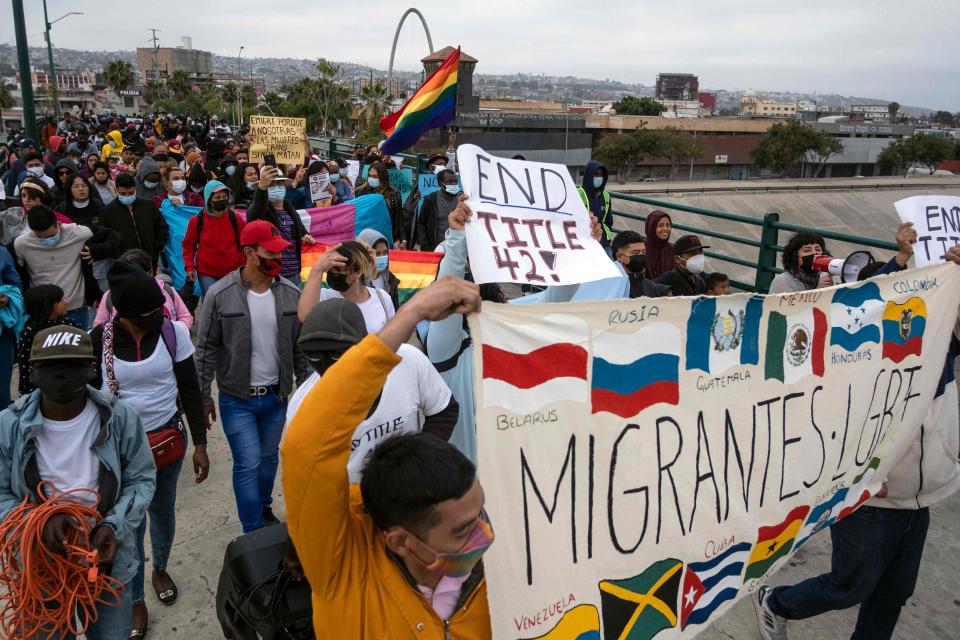Number of migrants at U.S.-Mexico border again predicted to smash previous records
Growing numbers of Mexicans, Hondurans, Cubans and Venezuelans are coming across the U.S.-Mexico border, while some U.S. policies may continue to funnel migrants into hazardous terrain.
The number of migrants encountered at the U.S.-Mexico border dipped slightly last month compared with the month before, but is still on pace to surpass last year’s record-breaking totals, according to statistics released this week by U.S. Customs and Border Protection.
“Repeat crossers” and other factors may skew the numbers somewhat, making them appear larger than they are, but the sheer number and variety of migrants arriving at the Southwest border are still at historic highs, said Adam Isacson, of the Washington Office on Latin America, a research and advocacy group.
Is this a record-breaking year for migrants encountered at U.S.-Mexico border?
The consensus is mostly yes. Border agents and officials encountered 199,976 migrants at the Southwest border, a 4% drop from June, when 207,933 were encountered, according to the CBP statistics. But, overall, 1.947 million migrants were encountered at the border this fiscal year from October 2021 through July. That number is already higher than the 1.7 million reported all of last fiscal year, then the highest number on record. (Numbers have approached those heights in decades past: 1.6 million in 1986 and again in 2000.)
Border officials said 22% of those encountered at the border were “repeat crossers,” or those picked up more than once in a year, which may overstate the total number, Isacson said. But even factoring in repeat crossers, the numbers are on pace to bust previous records.
“No matter how you measure it … this will be the largest year ever,” he said.
What is Title 42, and how did the pandemic affect immigration numbers?
Border agents and officials continue to expel migrants at the border under Title 42, the pandemic-era rule that allows agents to remove migrants without processing their asylum claims to avoid the spread of the coronavirus. In July, 74,573 migrants encountered at the Southwest border – or 37% – were removed from the U.S. under Title 42, according to CBP statistics.
Many immigrants avoid Title 42 and are allowed into the U.S. to face removal proceedings because the U.S. lacks diplomatic relations with their home country or some regions of Mexico decline to take them. The Biden administration has kept Title 42 in place under court order.

Many of those who are expelled under the public health order, finding themselves mired in dangerous northern Mexico towns, simply cross again to seek asylum, said Jason De León, executive director of the Tucson-based Colibri Center for Human Rights, an advocacy group.
Title 42 also creates more danger for migrants by forcing them to try to cross in more desolate, hazardous areas, he said.
This critique echoes other criticisms of border policies. Advocates have long said that strengthened border barriers – such as border walls – push crossers into more remote areas or dangerous crossing methods, leading to more rescues and more deaths. Title 42 creates similar pressures, De León said.
Border agents have already conducted 18,897 search-and-rescue events this fiscal year through July, higher than the record-breaking 12,883 all last fiscal year, which ends in September.
“Some people who never intended to undertake a border crossing are crossing more remote areas,” De León said.
Who is arriving at the U.S.-Mexico border?
Just over half – or 52% – of migrants encountered at the U.S.-Mexico border came from Mexico and the three “Northern Triangle” Central American countries of El Salvador, Guatemala and Honduras.
Other countries seeing large influxes of its citizens at the Southwest border include Cuba (20,159), Venezuela (17,651), Colombia (13,459) and Nicaragua (12,076), according to CBP statistics. Also, 5,396 Haitians were picked up at the border.

The surge in migrants from countries not historically common sources of migration to the U.S.-Mexico border points to a global trend of people fleeing pandemic-ravaged economies and unstable governments, Isacson said.
“People are on the move everywhere,” he said.
Another factor driving migrants to the U.S.-Mexico border: a robust U.S. job market, said Tony Payan, director of the Mexico Center at Rice University in Houston. The labor market added more than 500,000 jobs last month, exceeding expectations, and the unemployment rate dropped to a pre-pandemic rate of 3.5%, according to U.S. labor statistics.
"At the end of the day, the U.S. continues to be a very attractive job market, and migrants tend to track that very carefully," Payan said.
Are unaccompanied minors still arriving to the U.S.?
Yes, though their numbers are waning. Encounters of unaccompanied children decreased from 15,255 in June to 13,299 in July, a 13% drop. So far this fiscal year, border agents have encountered more than 128,000 unaccompanied minors.
Follow Jervis on Twitter: @MrRJervis.
This article originally appeared on USA TODAY: The number of migrants at U.S.-Mexico border on pace to break records

 Yahoo Movies
Yahoo Movies 
